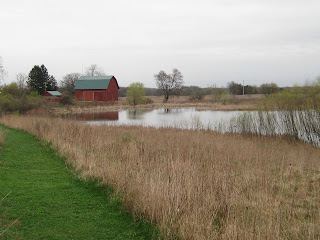Saturday, March 24, 2012
March 24
Saturday was a good day at Forest Hill for a hike with my dog, Remi. The early morning weather was mostly cloudy with temperature of 50 degrees and a slight northeast wind bringing a familiar smell from the dairy farm next door. Before beginning my hike, I faced east to acknowledge the hidden sun for its recent crossing of the celestial equator at the vernal equinox to begin warming the northern hemisphere. Next, I turned my gaze to the western landscape. I descended the hill and paused at Mallard Marsh to see a muskrat swimming by a pair of floating geese. Passing through Bobolink Meadow, I spotted my first of 6 crayfish walking slowing on the trail. Also, to my left a single quacking Mallard took off and to my right a Killdeer called out from the neighbor’s field. At the entrance to North Woods I turned south to Willow Wallow. Continuing west through Succession Field, I saw two doe standing still far to the west. I was surprised how close I got before they darted into North Woods. I stopped at the decomposing deer and observed a Carrion Beetle feeding on what remained of the flesh. At this stage what is left is being broken down into its constituent chemicals by a host of creatures including these beetles as well as flies, maggots and worms. Collectively these are know as decomposers. The lives of these organisms depend on the death of others. During the process of decomposition, they provide food for themselves by extracting chemicals from the dead deer, using those to produce energy. The decomposers will then produce waste of their own. In turn, this will also decompose, eventually returning nutrients to the soil. These nutrients will be taken up by the roots of living plants enabling them to grow and develop, so that organic material is naturally recycled. Virtually nothing goes to waste in nature. Next, I continued around the field and circled back toward Willow Wallow where I noticed the willows were greening up. I passed the pond and noticed that the Autumn Olive bushes that we didn’t kill last fall were starting to leaf out. I continued east and climbed Reflection Hill where I looked out over Grebe Pond. I descended the hill, passed Frog Fen and headed toward Brady Cemetery. Approaching the cemetery, I looked over the 2 acres of charred vegetation caused by a grass fire earlier in the week. Also, some of the small white pine trees had yellow needles due to heat from the fire. I passed the cemetery and entered Native Grassland. Following the trail north, I glanced once again at Grebe Pond where I spotted 10 Geese, 4 Mallards and 3 Mergansers. I continued toward the barn and arrived at the Classroom Building. Finally, another great hike was over as Remi and I took off for home.
Thousands of golden trumpets are raised
To herald the return of Spring;
Daylight, gradually returning again,
Birds chatter, and chirp and sing.
Cold days have passed us by once more,
Another Winter is thankfully over;
Spring brings with it, an sense of brightness,
Of fields carpeted with lucky clover.
Roadside verges explode with a fusion of colour,
As bulbs that had laid dormant, reappear;
Vast stretches, like an artists palette,
Yes, Spring is certainly here.
Jim Bell
Subscribe to:
Post Comments (Atom)

1. I have NEVER seen a crayfish out of the water! And you saw 6 in one hike?
ReplyDelete2. You could do an interesting study on what flora and fauna return to the burnt area and in what order.